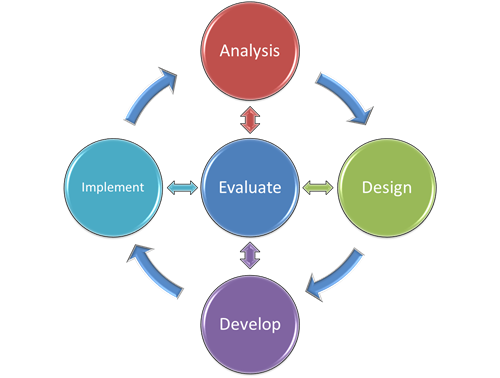3 ADDIE: A Framework for Exploring ID
What is the ADDIE Model?
The ADDIE model is a process model that is frequently used to organize the stages of instructional design and development projects (Kurt, 2019). ADDIE consists of five (5) stages:
- Assess
- Design
- Develop
- Implement
- Evaluate
The ADDIE model is frequently depicted as a linear process:

However, I like to think of ADDIE as being more of a cyclical process, with Evaluation always at the center, forming a hub for everything that we do when creating courses or digital learning resources.

How Are We Going to Use ADDIE?
The rest of this book (and this course, if you are using this book as part of one of my instructional design and development courses!) will follow the ADDIE structure. First, we will take a look at the Assess (or Analysis) stage, and determine what information you need before you begin your own instructional design project. Then, we will explore some of the tools and processes that I have used when designing ID projects. This will be followed by a section with tips, tricks, and resources to help you get through the development phase as you build your first draft or prototype of an ID project. After that, we will look at implementing your prototype through pilot testing with a live audience. Finally, we will take a look at evaluating an ID project, and how to make use of the feedback and data we have gathered to make revisions and improvements to our overall design.
A More Detailed Look at ADDIE
Watch J. Clark Gardner’s ADDIE video series for a more detailed look at the ADDIE model. The videos might take a bit of time to get through… but they are well worth it!
Assess/Analysis
Design
Develop
Implement
Evaluate
Further Reading
 Read Clark (2015) Why Instructional System Design and ADDIE for a more detailed introduction to this methodology and the reasons for following an ISD process.
Read Clark (2015) Why Instructional System Design and ADDIE for a more detailed introduction to this methodology and the reasons for following an ISD process.
References
Clark, D. (2015). Why Instructional System Design and ADDIE? Instructional System Design: The ADDIE Model: A Handbook for Learning Designers. http://knowledgejump.com/hrd/sat1.html
Gardner, J. Clark (2011, September 25). The ADDIE Analysis Phase. https://youtu.be/JZdv5lrJs4U
Gardner, J. Clark (2011, September 25). The ADDIE Design Phase. https://youtu.be/BhLIiF9QyTo
Gardner, J. Clark (2011, September 25). The ADDIE Development Phase. https://youtu.be/VzYDNWhQWYA
Gardner, J. Clark (2011, September 25). The ADDIE Implementation Phase. https://youtu.be/q8yky6-P1Uw
Gardner, J. Clark (2011, October 11). The ADDIE Evaluation Phase. https://youtu.be/CBoI0wBo4vw
Kurt, S. (2017, August 29). ADDIE Model: Instructional Design. [Web log post]. Educational Technology. https://educationaltechnology.net/the-addie-model-instructional-design/
